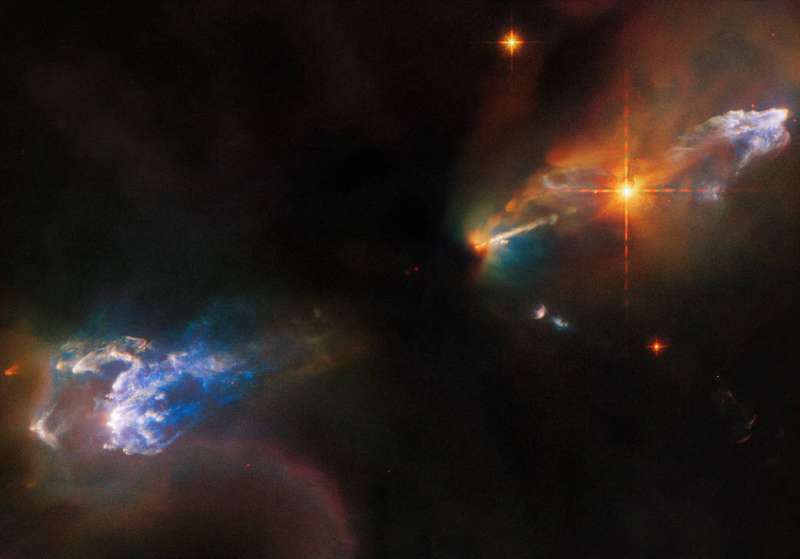Hubble views a turbulent stellar nursery

The lives of newborn stars are tempestuous, as this image of the Herbig-Haro objects HH 1 and HH 2 from the NASA/ESA Hubble Space Telescope depicts. Both objects are in the constellation Orion and lie around 1,250 light-years from Earth. HH 1 is the luminous cloud above the bright star in the upper right of this image, and HH 2 is the cloud in the bottom left. While both Herbig-Haro objects are visible, the young star system responsible for their creation is lurking out of sight, swaddled in the thick clouds of dust at the center of this image. However, an outflow of gas from one of these stars is streaming out from the central dark cloud and is visible as a bright jet. Astronomers once thought the bright star between that jet and the HH 1 cloud was the source of these jets, but it is an unrelated double star that formed nearby.
Herbig-Haro objects are glowing clumps found around some newborn stars. They form when jets of gas thrown outwards from these young stars collide with surrounding gas and dust at incredibly high speeds. In 2002, Hubble observations revealed that parts of HH 1 are moving at more than 248 miles (400 kilometers) per second!
Hubble’s Wide Field Camera 3 captured this turbulent stellar nursery using 11 different filters at infrared, visible, and ultraviolet wavelengths. Each of these filters is sensitive to just a small slice of the electromagnetic spectrum, and they allow astronomers to pinpoint interesting processes that emit light at specific wavelengths.
In the case of HH 1 and 2, two groups of astronomers requested Hubble observations for two different studies. The first delved into the structure and motion of the Herbig-Haro objects visible in this image, giving astronomers a better understanding of the physical processes occurring when outflows from young stars collide with surrounding gas and dust. The second study investigated the outflows themselves to lay the groundwork for future observations with the NASA/ESA/CSA James Webb Space Telescope. Webb, with its ability to peer past the clouds of dust enveloping young stars, will revolutionize the study of outflows from young stars.
Image: Hubble views an infant star’s outburst
Citation:
Hubble views a turbulent stellar nursery (2022, October 21)
retrieved 21 October 2022
from https://phys.org/news/2022-10-hubble-views-turbulent-stellar-nursery.html
This document is subject to copyright. Apart from any fair dealing for the purpose of private study or research, no
part may be reproduced without the written permission. The content is provided for information purposes only.
For all the latest Science News Click Here
For the latest news and updates, follow us on Google News.

